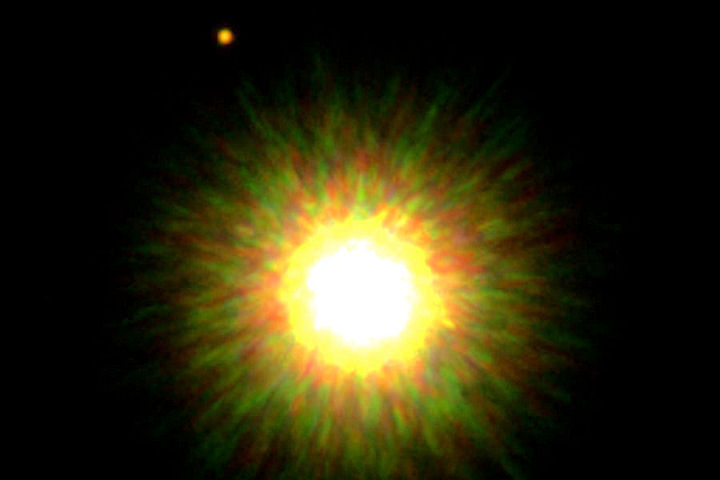

| Home Page | Overview | Site Map | Index | Appendix | Illustration | About | Contact | Update | FAQ |
 |
 |
too far away to be detected by the telescope. Recently, its presence has been deduced from the small perturbation on the movement of the central star, and HST (Hubble Space Telescope) was able to obtain pictures on the newborn planetary systems in the Orion Nebula as shown in Figure 07-01a. The photo on top shows a newborn star (the red dot) surrounded by dark, dusty disk of orbiting gas. The bottom photo shows the edge-on view of another star forming region. Some five billion years ago the solar system probably looked similar. Then, over the course of a few hundred million years, the dusty material clumped into the nine planets orbiting the Sun today. By 2009 a more |
Figure 07-01a Birth of Planetary System |
Figure 07-01b Birth of Planetary Systems [view large image] |
detailed images of the same region was taken with the Hubble Space Telescope. It shows at least six planetary systems at various stages of formation. |
 |
In the spring of 2005, an image of an extrasolar planet was finally captured by the combined effort of VLT, HST, and the Subaru Telescope (see Figure 07-01c). The mass of the planet is about two times that of Jupiter. It is about 100 times farther from the young star GQ Lupi than Earth is from the Sun. The star GQ Lupi is part of a star-forming region about 400 light-years away. It is about 1 million years old with 70% the mass of the Sun. The planet is only 156 times fainter than the star, because it is still very young and hence still forming, still contracting with a temperature of about 3000oF. This system resembles in some respects our own solar system in its formation years. Despite the observational difficulties, astronomers have found about 150 extrasolar planets over the past decade. It seems to indicate that formation of planetary system is a rather common phenomena. |
Figure 07-01c Extrasolar Planet |
 |
 |
More exoplanet images are revealed in 2010. The one in Figure 07-1d is still in the process of formation and relatively bright in infrared light. The image was taken in 2008 but confirmed only recently by noting that the planet stayed with its parent star as background stars slightly shifted over time. At a distance of 330 au from the parent star, its rotational period would be about 5 thousand years making the motion of the planet (relative to the star) very difficult to detect within a few years. |
Figure 07-01d Exoplanet in Scorpius [view large image] |
Figure 07-01e Beta Pictoris b |
On the other hand another exoplanet at a distance of about 10 au from the young star Beta Pictoris has an orbital period between 17 - 44 years. Figure 07-01e is able to show its shifting positions in 6 years. |
 (semi-major axis)3/2.
(semi-major axis)3/2. |
JWST has revealed new observations about planetary disks in "EXOTIC CHEMISTRY OF PLANETARY NURSERIES", 2023. One of the new images shows the disk around Beta Pictoris, a star that lies 19 parsecs from Earth. In 1984, it became the first star known to have a encircling debris disk. It now shows a filament of dust that astronomers are calling the "catís tail", stretching from the debris disk (see Figure 07-01f). It is probably a stream of debris that was kicked out of the star's disk when large rocky chunks smashed into each other. |
Figure 07-01f Dusty Disk |